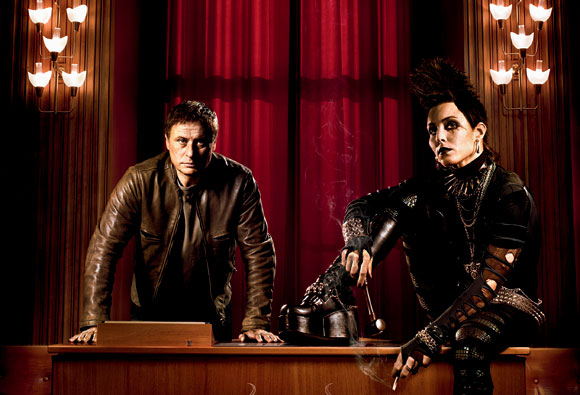Luftslottet Som Sprängdes (The Girl Who Kicked The Hornet’s Nest)

(L-R) Michael Nyqvist and Noomi Rapace as Michael Blomkvist and Lisbeth Salander in Music Box Films' THE GIRL WHO KICKED THE HORNET'S NEST.

All that is necessary for the triumph of evil is that good men do nothing. – Edmund Burke
Adapted for the screen by Jonas Frykberg, Stieg Larsson’s Millennium trilogy concludes with this vengeful thriller directed by Daniel Alfredson. Michael Nyqvist and Noomi Rapace return as, respectively, magazine editor Mikael Blomkvist and hacker Lisbeth Salander.
In the first chapter, The Girl with the Dragon Tattoo, Salander and Blomkvist’s worlds collide when she is hired by the Vanger clan to investigate Blomkvist, who was imprisoned for libel against Swedish industrialist Hans-Erik Wennerström. After Salander’s investigation of Blomkvist exposes Wennerström’s even deeper corruption, she returns to Stockholm in The Girl Who Played With Fire. She finds herself confronting old enemies, including her perverted guardian Nils Bjurman. His death points to a mysterious figure named Zalachenko, whose secrets are of mutual interest to Blomkvist and Salander. The confrontation with Zalachenko proves nearly fatal, and the third chapter opens with Lisbeth and Zalachenko in Sahlgrenska Hospital at the University of Gothenburg. After narrowly escaping death at her father’s retreat, several bullets in her shoulder, hip and head, Lisbeth lies in a hospital bed, vulnerable to whatever forces will converge upon her next.
The intriguing distinction between this trilogy and the typical American movie franchise lies in the sprawling structure of its narrative. While the Vanger clan’s odious behavior dominates the first installment, the story continues forward into the complications of Zalachenko and the larger cover up without returning to Vanger and Wennerström. For sure, an American film would have connected Lisbeth’s silencing with Wennerström’s industrial empire. But no such contrivance exists here. The story continues onward, rather than circuitously. At its conclusion you’re nowhere near where you started, nor are you waiting for the twist to drag you back to the beginning to tie up all narrative threads in one neat bow. Along with the protagonists, you’ve traveled some distance.
This climactic episode expands upon Salander’s relatonship with Dr. Peter Teleborian (Anders Ahlbom Rosendahl) in a series of depositions and ultimately the court hearing in which the state is trying to get Salander committed to a psychiatric institution, under Teleborian’s care—silenced for good. Mr. Rosendahl’s portrayal of teleborian may seem weak, ineffective. However, I think there may be a cultural gap behind that misperception. American filmgoers tend to like their antagonists to be calculating, evil and prone to only the kind of missteps that slow down the plot just enough to fill the running time with more chases. This gives rise to action-driven drama. However, it wouldn’t serve this trilogy well for Teleborian to be the same character as Zalachenko and the Swedish intelligence officials covering up his existence. However mundane Teleborian seems, his offenses appear more gruesome without laborious exposition.
It’s said that Mr. Larsson wrote the trilogy out of a measure of guilt for witnessing the gang rape of a fifteen-year old girl and failing to come to her aid. The clandestine matters of the Vanger clan, Zalachenko and state are only a backdrop against the story of Lisbeth’s sexual abusers and her revenge upon them. While the third installment may seem to lose steam, its an intellectual climax as the particulars of Lisbeth’s case unfold before an untheatrical magistrate. Thankfully, the courtroom seats have also been cleared so we, the audience, may be spared the cartoonish gasps and whispers that plague every courtroom drama this side of the Atlantic. The film does end outside the courtroom, but doesn’t take the maudlin turn one might have expected as Lisbeth circles back to her half-brother, Ronald Niedermann (Mikael Spreitz).
In my review of the first installment in the trilogy, I wrote, “Unlike many American films, which pander to the audience with easily digestible absolutes, The Girl With the Dragon Tattoo treats criminality as a grey area—at what point is an individual responsible for who family or society has made them?” It is not by coincidence that, for her court appearance, Lisbeth dons a mohawk and eyeliner streaked in rays down her cheek, resembling Alex deLarge from Stanley Kubrick’s A Clockwork Orange. DeLarge, Mr. Kubrick’s film argued, was a criminal who became a victim of the state. Lisbeth became a criminal to protect herself from the state that abused her.
As journalists, our job is partly to inform, but also to comment on society. The decentralization of the information economy is the greatest threat to tyranny. When Millennium‘s staff begins to receive anonymous death threats, even Mikael’s relationship with his close friend Erika Berger (Lena Endre) is strained to its limits. Why does he risk their lives for Salander? Berger accuses him of vanity when he publishes her story. But the autobiography serves a purpose other than stroking Mikael’s ego. When corrupt people hide behind the rules of evidence in the very system they control, the free press becomes one’s only recourse. Mikael is Mr. Larsson’s wish that he had been a hero to the real Lisbeth. Unfortunately, he didn’t live to see how his books, and their film adaptations, might inform and inspire others to put their jobs, reputations and even lives on the line to end all forms of victimization.
 The Girl Who Kicked The Hornet’s Nest • Dolby® Digital surround sound in select theatres • Aspect Ratio: 1.85:1 • Running Time: 148 minutes • MPAA Rating: R for strong violence, some sexual material, and brief language. • Distributed by Music Box Films
The Girl Who Kicked The Hornet’s Nest • Dolby® Digital surround sound in select theatres • Aspect Ratio: 1.85:1 • Running Time: 148 minutes • MPAA Rating: R for strong violence, some sexual material, and brief language. • Distributed by Music Box Films
Dolby and the double-D symbol are registered trademarks of Dolby Laboratories.